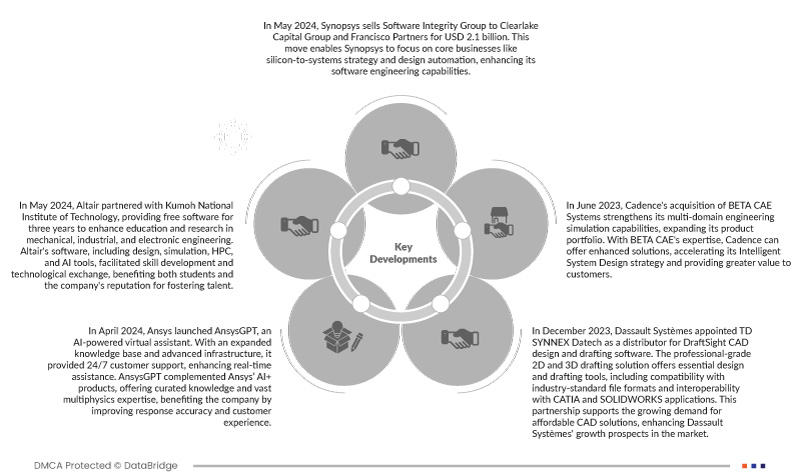Cloud-based solutions offer unparalleled flexibility and scalability, allowing engineers to access critical tools and data from anywhere with an internet connection. This mobility empowers teams to collaborate seamlessly across geographical boundaries, breaking down traditional barriers to communication and enhancing productivity. Furthermore, cloud-based solutions are changing the engineering software market by improving accessibility, accelerating innovation, and optimizing workflows. This gives businesses the flexibility they need to compete and prosper in the fast-paced business world of today.
Access Full Report @ https://www.databridgemarketresearch.com/reports/global-software-engineering-market
Data Bridge Market Research analyses that the Global Engineering Software Market is expected to reach a value of USD 86.45 billion by 2031, from USD 45.63 billion in 2023, growing at a CAGR of 8.5% during the forecast period of 2024 to 2031.
Key Findings of the Study
Rising Investments in Infrastructure Projects
The rising investments in infrastructure projects worldwide serve as a significant driver for the global engineering software market. As governments and private sectors allocate substantial funds towards infrastructure development, the demand for engineering software solutions intensifies. These investments span a wide range of projects, including transportation, energy, water supply, and urban development, among others. Engineering software plays a crucial role in these projects by enabling engineers to design, simulate, and manage complex infrastructure systems effectively.
Report Scope and Market Segmentation
|
Report Metric
|
Details
|
|
Forecast Period
|
2024 to 2031
|
|
Base Year
|
2023
|
|
Historic Year
|
2022 (Customizable to 2016-2021)
|
|
Quantitative Units
|
Revenue in Billion
|
|
Segments Covered
|
Software Type (Electronic Design Automation (EDA), Computer-Aided Designing (CAD), Architecture, Engineering & Construction (AEC), Computer-Aided Engineering (CAE), and Computer-Aided Manufacturing (CAM)), Application (Product Design, 3D Modelling, Automation Design, Plant Design, and Others), Enterprise Size (Large Enterprise, Medium Enterprise, and Small Enterprise), End Users (Automotive, Aerospace & Defense, Oil & Gas, IT & Telecommunication, Healthcare, and Others)
|
|
Countries Covered
|
U.S., Canada, Mexico, Germany, France, U.K., Netherlands, Switzerland, Belgium, Russia, Italy, Spain, Turkey, rest of Europe, China, Japan, India, South Korea, Malaysia, Australia, Singapore, Thailand, Philippines, Indonesia, rest of Asia-Pacific, Saudi Arabia, U.A.E., South Africa, Egypt, Israel, rest of Middle East and Africa, Brazil, Argentina, and rest of South America
|
|
Market Players Covered
|
Autodesk Inc. (U.S.), Synopsys, Inc. (U.S.), Dassault Systèmes (France), ANSYS, Inc (U.S.), Cadence Design Systems, Inc. (U.S.), The MathWorks, Inc. (U.S.), PTC (U.S.), Siemens (Germany), Bentley Systems, Incorporated (U.S.), Hexagon AB (Sweden), Altair Engineering Inc. (U.S.), Altium Limited (U.S.), HCL Technologies Limited (India), AVEVA Group (Subsidiary Of Schneider Electric) (U.K.), BY COMSOL (U.S.), BETA CAE Systems (Switzerland), CNC Software, LLC (A Subsidiary of Sandvik AB) (U.S.), Carlson Software (U.S.), ESI Group (France), ZWSOFT CO., LTD. (China), SimScale (Germany), Computers and Structures, Inc.(U.S.) among others
|
|
Data Points Covered in the Report
|
In addition to the market insights such as market value, growth rate, market segments, geographical coverage, market players, and market scenario, the market report curated by the Data Bridge Market Research team includes in-depth expert analysis, import/export analysis, pricing analysis, production consumption analysis, and pestle analysis.
|
Segment Analysis
Global engineering software market is segmented into four segments based on software type, applications, enterprise size, and end user.
- On the basis of software type, the global engineering software market is segmented into Electronic Design Automation (EDA), Computer-Aided Designing (CAD), Architecture, Engineering & Construction (AEC), Computer-Aided Engineering (CAE), Computer-Aided Manufacturing (CAM)
In 2024, Electronic Design Automation (EDA) segment is expected to dominate the Global Engineering Software Market
In 2024, Electronic Design Automation (EDA) segment is expected to dominate the market with a market share of 31.52% due to its critical role in semiconductor and electronic design, catering to a burgeoning demand for integrated circuits and electronic systems.
- On the basis of application, the global engineering software market is segmented into product design, 3D modelling, automation design, plant design and others.
In 2024, product design segment is expected to dominate the Global Engineering Software Market
In 2024, product design segment is expected to dominate the market with a market share of 36.65% due to its essential role in diverse industries, empowering designers with tools for concept creation, prototyping, and visualization, driving innovation and efficiency.
- On the basis of enterprise size, the global engineering software market is segmented into large enterprises, medium enterprises, and small enterprises. In 2024, the large enterprises segment is expected to dominate the market with a market share of 57.32%
- On the basis of end user, the global engineering software market is segmented into automotive, aerospace & defense, oil & gas, IT & telecommunication, healthcare, and others. In 2024, the automotive segment is expected to dominate with a market share 31.84%
Major Players
Data Bridge Market Research analyzes Autodesk, Inc (U.S.), Synopsis, Inc. (U.S.), Dassault Systèmes (France), ANSYS, Inc (U.S.), and Cadence Design Systems, Inc. (U.S.) as the major players of the global engineering software market.
Market Developments
- In May 2024, Synopsys sells Software Integrity Group to Clearlake Capital Group and Francisco Partners for USD 2.1 billion. This move enables Synopsys to focus on core businesses like silicon-to-systems strategy and design automation, enhancing its software engineering capabilities
- In May 2024, Altair partnered with Kumoh National Institute of Technology, providing free software for three years to enhance education and research in mechanical, industrial, and electronic engineering. Altair's software, including design, simulation, HPC, and AI tools, facilitated skill development and technological exchange, benefiting both students and the company's reputation for fostering talent
- In April 2024, Ansys launched AnsysGPT, an AI-powered virtual assistant. With an expanded knowledge base and advanced infrastructure, it provided 24/7 customer support, enhancing real-time assistance. AnsysGPT complemented Ansys’ AI+ products, offering curated knowledge and vast multiphysics expertise, benefiting the company by improving response accuracy and customer experience
- In December 2023, Dassault Systèmes appointed TD SYNNEX Datech as a distributor for DraftSight CAD design and drafting software. The professional-grade 2D and 3D drafting solution offers essential design and drafting tools, including compatibility with industry-standard file formats and interoperability with CATIA and SOLIDWORKS applications. This partnership supports the growing demand for affordable CAD solutions, enhancing Dassault Systèmes' growth prospects in the market
- In June 2023, Cadence's acquisition of BETA CAE Systems strengthens its multi-domain engineering simulation capabilities, expanding its product portfolio. With BETA CAE's expertise, Cadence can offer enhanced solutions, accelerating its Intelligent System Design strategy and providing greater value to customers
Regional Analysis
Based on geography, the market is segmented into U.S., Canada, Mexico, Germany, France, U.K., Netherlands, Switzerland, Belgium, Russia, Italy, Spain, Turkey, rest of Europe, China, Japan, India, South Korea, Malaysia, Australia, Singapore, Thailand, Philippines, Indonesia, rest of Asia-Pacific, Saudi Arabia, U.A.E., South Africa, Egypt, Israel, rest of Middle East and Africa, Brazil, Argentina, and rest of South America.
As per Data Bridge Market Research Analysis:
North America is dominating region in the Global Engineering Software Market
North America is expected to dominate the global engineering software market due to robust research funding, innovative technology hubs, and a culture fostering entrepreneurship and collaboration, resulting in cutting-edge advancements. In addition, the region benefits from a strong ecosystem of universities, tech companies, and talent, driving continual progress in humanoid robotics. This leadership position underscores North America's pivotal role in shaping the future of robotics worldwide.
Asia-Pacific region is expected to be the fastest growing region in the Global Engineering Software Market
Asia-Pacific region is expected to be the fastest growing region in the global engineering software market due to rapid technological advancements and extensive investment in automation across industries, driving robust demand for humanoid robots and fostering innovation. In addition, the region's burgeoning manufacturing sector and increasing adoption of humanoid robots for tasks such as customer service and healthcare are key factors propelling its rapid growth trajectory.
For more detailed information about the Global engineering software market report, click here – https://www.databridgemarketresearch.com/reports/global-software-engineering-market
















